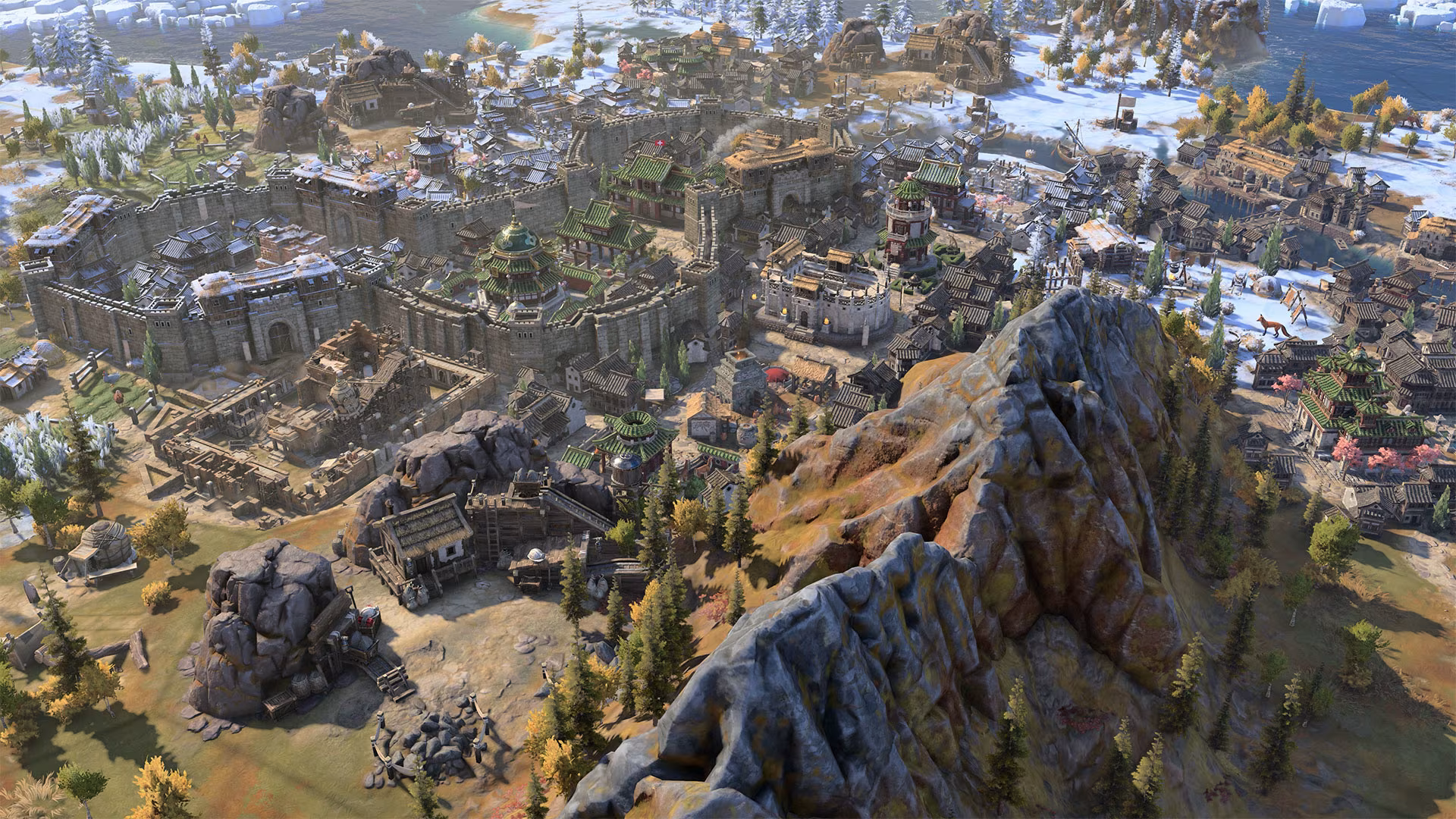World Builder
World Builder
•
With more than 70 million copies sold and more than 1 billion hours played, the computer game series Sid Meier’s Civilization has solidified its empire in the gaming industry since 1991.
But creator Sid Meier, ’75, had never seen a computer in person before arriving as a student at the University of Michigan in 1971.
Though Meier enrolled as a physics and math major, the “ultra-logical nature” of computers intrigued him. He signed up for his first programming class, quickly changing his major to computer science and taking a job for a professor who needed some relatively simple computer work done, though on more advanced computers than what was available to him as a student. Fortunately for Meier, professor Noah Sherman, MA’49, PhD’52, encouraged him to experiment once his work was done and even left him the key to the lab while away for the summer.
Meier’s self-assigned project involved getting the computer to play tic-tac-toe. He inputted a simple text input scheme into the punch card machine, which allowed players to enter one move at a time and challenge a computer.
“I hadn’t figured out how to get the computer to display its next move on the screen yet, so instead, I instructed it to send the grid to the nearest printer, which was stored in a separate room and shared by everyone in the building,” Meier wrote in his 2020 memoir.
“After the third or fourth document containing nothing but Xs and Os, the woman running the output desk was on to me, ‘Wait a minute’ she said, snatching back the paper she’d just handed over, ‘What do you think you’re doing? Computers are not for games!’”
They took Meier to a phone and called his professor. After hearing about Meier’s activities, Sherman permitted his experimentation — a practice he has never stopped.
“My first attempt didn’t work perfectly, but showed potential,” Meier says. “Thus began my lifelong practice of iterating and finding the fun.”

The History of Civilization
After graduating, Meier worked for General Instruments, programming cash registers across Michigan and dabbling in coding games in his spare time. Because one of the company’s interests was gambling machines, Meier was sent to an industry convention in Las Vegas, where he made a connection with fellow General Instruments employee and Air Force veteran Bill Stealey.
Stealey saw the promise in Meier’s game designing skills and the two formed a game studio, MicroProse, in 1982. Though initially a “nights-and-weekends” operation with Stealey leading sales and a few additional employees, the company developed combat flight simulators Hellcat Ace and Spitfire Ace, released in 1982; Solo Flight in 1983; andF-15 Strike Eagle in 1984.
Meier remained with General Instruments part-time until Stealey told him their venture was profitable enough that he could commit to game design exclusively. In 1986, MicroProse hit $10 million in sales. One product, Sid Meier’s Pirates!, berthed in 1987, became a huge hit, though nothing compared to the “ultimate strategy game” Meier envisioned he would one day create.
In simplest terms, Civilization gives players the chance to begin their own civilization in 4,000 B.C. and then direct it thousands of years into the future, in command every step of the way, from sticks and stones to spacecraft and nuclear weaponry.
That level of control, not pure historical accuracy, is what Meier says makes the game fun.
“It didn’t matter that gunpowder, for example, was originally developed for medicinal purposes in China,” Meier said in his memoir. “What mattered is that you, as a civilization, could have discovered it any time after the perfection of iron smelting. You were rewriting history, not reliving it.
U-M professor Austin Yarger, ’15, MSE’18, says the Civilization series pioneered and enhanced the popular and addictive 4X (which stands for eXplore, eXpand, eXploit, eXterminate) subgenre of digital strategy games. Other titles in the genre include Stellaris (2016), Master of Orion (1993), and the Age of Wonders franchise.
“While it is now a somewhat crowded market, Civilization continues to shine for its dedication to history and its grounded, educational spirit,” Yarger says. “Its creators have a clear reverence for humanity — all our progress and perils — that shines through on every turn. Every last darn turn.”
“One more turn” is an unofficial slogan of the series, a nod to the addictive nature of what amounts to 500 turns in a standard game, though players can choose a game mode with as few as 250 or as many as 1,500 turns in a single campaign. Meier said the “one more turn” aspect so synonymous with Civilization is a very intentional feature.
“As players proceed through the game, they juggle challenges and, based on feedback after making decisions, they immediately start thinking, ‘I wonder what would happen if I did this instead of that next time’,” Meier says. “In other words, there’s always a world of possibilities in front of them.”

Advancements
Much as the world has changed throughout history, gaming has changed since the first Civilization title emerged. Each new iteration has come with new enhancements. For example, in the early games, you increased the scale of your empire’s territory square by square, but beginning with 2010’s Civilization V, players do so hexagon by hexagon.
“With each new game system, designers get to rethink the game’s assumptions and mechanics — it’s all very exciting to witness,” Meier says.
Meier espouses a rule of thirds when designing a sequel: 33 percent brand new features, 33 percent improving previous features, and 33 percent staying roughly the same.
The biggest innovation coming to the next Civilization installment — set to be released Feb. 11 — will be the Ages system, a seismic adjustment to gameplay based on feedback from longtime fans that divides a single game of Civilization into distinct playable chapters.
“As you go from one Age to the next, your empire evolves — you select a new civilization that comes equipped with a fresh set of bonuses, units, and buildings,” Ed Beach, creative director for Civilization VII, wrote in the game’s development blog. “This new civilization carries forward key elements of your past, and by the end of a campaign, you’ll have created a unique cultural lineage through history in your journey to build an empire that will stand the test of time.”
The idea for Ages emerged after the Civilization development team found that more than half of Civilization VI players had never finished a single campaign. Many players expressed that they enjoy the first 100 turns more so than they do later stages of the game, sometimes because decisions made early in the game can become insurmountable later on.
Meier says their combination of trying new ideas and listening to player feedback is “the secret sauce of the Civ design team.”
In the more than three decades since the series began, Civilization has expanded to many gaming platforms, spawned multiple expansion packs and spinoffs, and the franchise even includes three board games.
“Watching Civilization evolve over the years has been fantastic and very gratifying,” Meier says. “It’s been great to see the expanding nature of it — for instance, how parents have shared their love of Civilization with their children, and how new audiences continue to evolve.”

A New Generation
Since graduation, Meier has returned to U-M several times to speak to students aspiring to careers in the game industry.
In 2010, when his son, Ryan, ’11, was a computer science student at the University and president of the Wolverine Soft student organization, Meier participated in an annual tradition: the 48-hour game design challenge.
“I’d like to hope that part of my legacy is encouraging and inspiring other game designers to try new things,” Meier said during the visit. “I think game design is an art. You can put a lot of your personality and creativity into it. Games are so empowering and engrossing, and I hope I’ve had a little to do with encouraging that.”
In addition to judging the student-designed games, Meier made his own 48-hour game, in which the player is trapped in a maze and needs to escape from zombies. Like the maze, the game design industry can take serious resolve to break out from.
As a leader of the U-M game design community, Yarger has seen how Meier’s continued involvement with it has left a legacy.
“A student spends their childhood reading and hearing about hallowed names in game design, and it all feels so distant and impossible,” Yarger says. “One day, they arrive at Michigan and find themselves in the same spaces their heroes once were in. Suddenly, Sid Meier shows up for a 48-hour game jam or to run a game design boot camp and students realize that legends like Sid are not just real, but also genuine, earnest, humble, and willing to support future generations as they advance the craft.”
Yarger says Meier’s creative philosophy and entrepreneurial spirit continue to influence U-M game design courses and curricula today, and he sees Meier’s triumphant story inspire fledgling designers as much as ever.
“Passion doesn’t always pay the bills — particularly so in today’s volatile games industry — but that doesn’t mean we should give it up or leave it behind,” Yarger says. “It isn’t rare for my students to graduate without a game studio offer, but to obtain one after years of ‘working on the side’ to improve their portfolio and build their network. Sid’s experience tells us to keep that passion in our back pocket, progressing little by little, and waiting for opportunities (big and small) to make our impact on the world.”
Meier’s campus visits to students have always offered practical advice. One 2014 lecture, “Crossing the Valley of Despair: Maintaining Your Sanity While Designing Video Games,” reiterated the necessity of resilience.
“Having felt it myself, I wanted to normalize discouragement so students would not despair when their ideas weren’t immediately successful,” he says.
Despite the challenges and frustrations that can come with designing and developing games, Meier hopes his successes encourage others to keep iterating, playing, and designing games.
“I wanted young game designers to know that there is light at the end of the game development tunnel,” Meier says. “And that by sticking with their dream, humbly receiving feedback, and tweaking (or throwing out) designs, when necessary, they could be the creator of a great video game.”
Steve Zoski, ’13, is a freelance writer based in Dearborn, Michigan.



